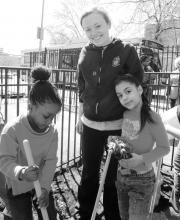In this lesson, we recognize that we all have biases and privileges. It is helpful to be aware of them so we see them as part of our identity and not a reason to judge or discriminate.
Filter by subjects:
Filter by grades:
Filter by audience:
Filter by issue area:
Filter by content type:
Filter by resource type:
resource search
In this book, Peter Reynolds writes a fable about what happens to one family’s table when life’s distractions get in the way of their time together. Violet remembers when her family gathered at the table to share stories and make memories.
This course provides an overview of strategies and the quality indicators of service-learning. Through stories, examples, and reflection questions, learners analyze what makes a service-learning experience meaningful.
This lesson is designed to expnd awareness about the famous suffragist Susan B. Anthony. Although she is best known for this role, she was active in six different causes as an abolitionist, educational reformer, labor activist, temperance worker, suffragist, and women's rights campaigner.
Three amendments to the Constitution extended voting rights to more citizens. Look at the language of these amendments and the effectiveness of everyone actually getting the vote. Youth discuss the purpose of voting, and they take action to make a difference, such as by making ...
In this lesson, learners read primary documents that illustrate the motivations of the founding fathers of the United States related to philanthropy (government by the people, advocacy, civil rights, shared power). We have a long history of demanding civil rights for a population that was...
Students identify key events in U.S. history and the magnitude of the Constitution in context, with a particular emphasis on philanthropy. This lesson is designed for Citizenship/Constitution Day (September 17) and connects students to the historical significance of the...
Students explore the components of the Preamble of the U.S. Constitution and apply them to their own lives, with a particular emphasis on philanthropy. This lesson is designed for Citizenship/Constitution Day (September 17) and connects students to the community-building focus of the...
Students identify the components and rationale behind the Constitution, with a particular emphasis on philanthropy. This lesson is designed for Citizenship/Constitution Day (September 17) and connects students to the community-building focus of the Constitution and how it relates personally to...
Students learn how the Constitution relates to rules and community roles. This lesson is designed for Citizenship/Constitution Day (September 17) and connects students to improving their community for the good of all.

